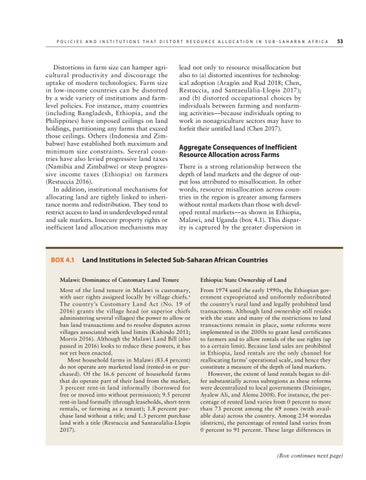P o l i c i e s a n d I n s t i t u t i o n s t h a t D i s t o r t R e s o u r c e A ll o ca t i o n i n S u b - Sa h a r a n A f r i ca
Distortions in farm size can hamper agricultural productivity and discourage the uptake of modern technologies. Farm size in low-income countries can be distorted by a wide variety of institutions and farmlevel policies. For instance, many countries (including Bangladesh, Ethiopia, and the Philippines) have imposed ceilings on land holdings, partitioning any farms that exceed those ceilings. Others (Indonesia and Zimbabwe) have established both maximum and minimum size constraints. Several countries have also levied progressive land taxes (Namibia and Zimbabwe) or steep progressive income taxes (Ethiopia) on farmers (Restuccia 2016). In addition, institutional mechanisms for allocating land are tightly linked to inheritance norms and redistribution. They tend to restrict access to land in underdeveloped rental and sale markets. Insecure property rights or inefficient land allocation mechanisms may
53
lead not only to resource misallocation but also to (a) distorted incentives for technological adoption (Aragón and Rud 2018; Chen, Restuccia, and Santaeulàlia-Llopis 2017); and (b) distorted occupational choices by individuals between farming and nonfarming activities—because individuals opting to work in nonagriculture sectors may have to forfeit their untitled land (Chen 2017).
Aggregate Consequences of Inefficient Resource Allocation across Farms There is a strong relationship between the depth of land markets and the degree of output loss attributed to misallocation. In other words, resource misallocation across countries in the region is greater among farmers without rental markets than those with developed rental markets—as shown in Ethiopia, Malawi, and Uganda (box 4.1). This disparity is captured by the greater dispersion in
BOX 4.1 Land Institutions in Selected Sub-Saharan African Countries Malawi: Dominance of Customary Land Tenure
Ethiopia: State Ownership of Land
Most of the land tenure in Malawi is customary, with user rights assigned locally by village chiefs. a The country’s Customary Land Act (No. 19 of 2016) grants the village head (or superior chiefs administering several villages) the power to allow or ban land transactions and to resolve disputes across villages associated with land limits (Kishindo 2011; Morris 2016). Although the Malawi Land Bill (also passed in 2016) looks to reduce these powers, it has not yet been enacted. Most household farms in Malawi (83.4 percent) do not operate any marketed land (rented-in or purchased). Of the 16.6 percent of household farms that do operate part of their land from the market, 3 percent rent-in land informally (borrowed for free or moved into without permission); 9.5 percent rent-in land formally (through leaseholds, short-term rentals, or farming as a tenant); 1.8 percent purchase land without a title; and 1.3 percent purchase land with a title (Restuccia and Santaeulàlia-Llopis 2017).
From 1974 until the early 1990s, the Ethiopian government expropriated and uniformly redistributed the country’s rural land and legally prohibited land transactions. Although land ownership still resides with the state and many of the restrictions to land transactions remain in place, some reforms were implemented in the 2000s to grant land certificates to farmers and to allow rentals of the use rights (up to a certain limit). Because land sales are prohibited in Ethiopia, land rentals are the only channel for reallocating farms’ operational scale, and hence they constitute a measure of the depth of land markets. However, the extent of land rentals began to differ substantially across subregions as these reforms were decentralized to local governments (Deininger, Ayalew Ali, and Alemu 2008). For instance, the percentage of rented land varies from 0 percent to more than 73 percent among the 69 zones (with available data) across the country. Among 234 woredas (districts), the percentage of rented land varies from 0 percent to 91 percent. These large differences in
(Box continues next page)



